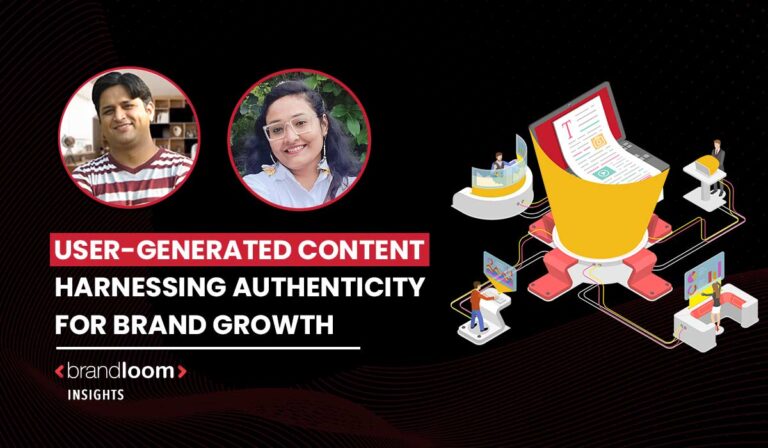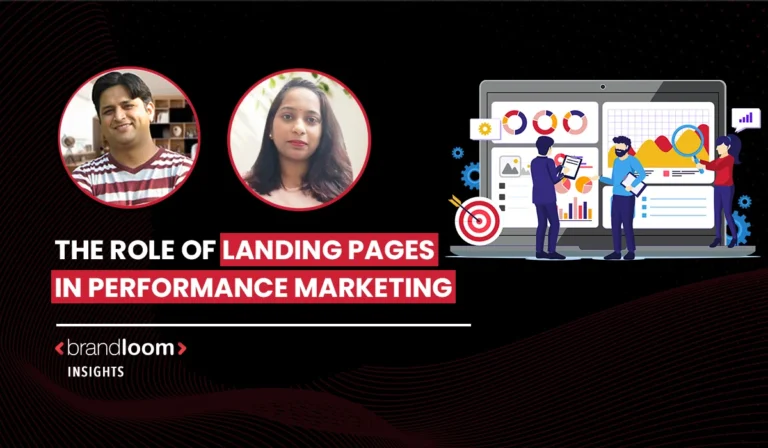Think about the most recent time you purchased something. Was it thanks to a polished advertisement or because someone you trust shared their real experience? More than anything else, it’s that off-the-cuff post, that whirlwind review, that snap candid photo whose processing required a swipe up and nothing more. It is user-generated content (UGC), and it is quietly transforming the way brands engage with people.
In a digital landscape that can feel chaotic and cluttered, UGC stands out with something we all desire: authenticity. It is relatable, raw, and delightfully frank bit of real. And when brands make it their own as a tool with which to listen, engage, and co-create, they tap into something truly transcendent. This blog will give you a closer look at the world of user-generated content and how leveraging UGC for brand trust can maximize the profit margin of businesses.
What Is User Generated Content (UGC)?
When content is planned, prepared, and posted by the customer, it is referred to as user generated content (UGC). Brands can increase trust with customer content and reach out to more potential buyers.
This content is genuine and is considered highly credible by the target audience. Authentic brand storytelling with UGC can help brands achieve their sales objectives.
Using UGC in social media campaigns can expand visibility, enabling the brand to reach a vast audience across various channels.
The best examples of user-generated content include reviews, testimonials, etc. Real customer reviews for marketing purposes can motivate potential customers to choose your product.
Through these, brands promote their product without paying hefty fees for endorsements. If you encourage customers to share content with clear instructions, you will get plenty of high-quality UGC.
Images or videos are more effective for influencing buying decisions. User-generated visuals for eCommerce can maximize sales in no time.
Types Of User Generated Content (UGC)
Authentic brand storytelling with UGC can boost revenue over time. However, one must know about different types of UGC that can help with trust-building and brand growth.
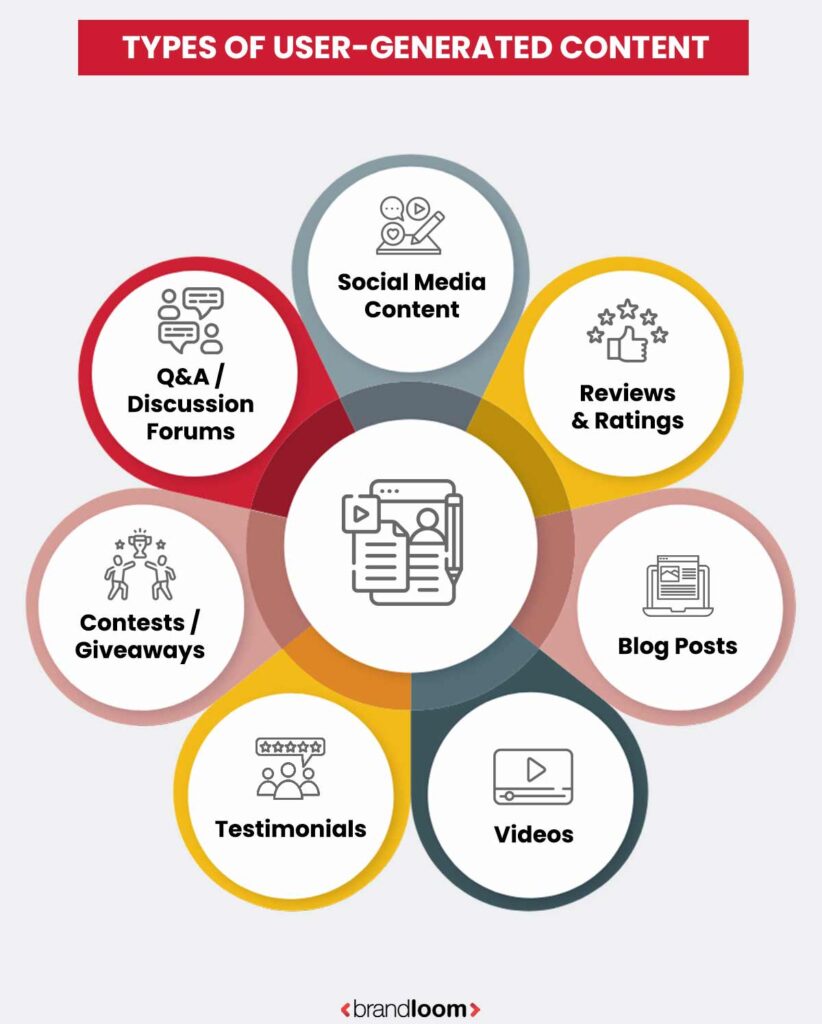
- Social Media Content: Users share their experience across social channels like Facebook, Instagram, Twitter (X), etc.
- Reviews and Ratings: Users review or rate products at the site from which they have purchased or on the social page dedicated to that brand.
- Blog Posts: Users publish their experience in the form of blog content. Here, they provide a detailed overview of the product, their purchase experience, and feedback on the product after using it for a while.
- Videos: Users shoot videos where they describe the product and their opinions after using it. The videos can be long-form like YouTube videos or short-form like Instagram reels or YouTube shorts.
- Testimonials: Personal stories or case studies, testimonials can be of different types. The goal is to showcase real user experience to drive sales.
- Contests: Whenever brands start any social challenges, many users are a part of it. Hence, many UGC are generated through engagement.
- Q&A / Discussion Forums: These are public forums where individuals share their experiences. This is a great source of keyword-rich UGC.
Why Authenticity Matters In Modern Branding?
In an era when the audience is bombarded with numerous ads at every step, authenticity cries in the corner.
Whether you are watching a video or just scrolling through your social feeds, there are advertisements all over. It is evident that these ads are too perfect to believe.
One celeb endorsing many brands also brings trust issues. Especially, in this age of the internet, when almost everyone is aware of paid marketing, it is difficult to make your target market believe a polished ad to be a fruit of real experience.
Even the brands are aware of this; therefore, they are looking for something more genuine to attract their customer base. Trust and authenticity are something that cannot be bought or traded.
These are earned from loyal customers who are happy with their experience. In modern branding, authenticity pulls more customers than fabricated endorsements.
The Impact Of User Generated Content (UGC) On Brand Growth
As more brands are craving an organic connection with their customer base, the concept of user-generated content is like a breath of fresh air. According to Addsauce (2024), UGC increases conversions by 29%. Several factors associated with UGC are linked to positive brand growth. Let us explore.
1. Authenticity & Credibility
As the user generated content (UGC) comes from a real customer, it is perceived as a major source of trust. This content is authentic and deemed more credible than a traditional ad.
The buyers are more likely to purchase from an organization with UGC rather than one with big-shot celebrities endorsing the products.
The thin line of authenticity distinguishes UGC from the rest. It eliminates buying hesitation by winning consumers’ trust and escalating growth.
2. Higher Reach & Engagement
When a customer shares UGC, it automatically helps the brand to use that individual’s contact or followers to promote their product.
As the authenticity of the content leads to higher engagement, with increased comments and shares, the post gains further reach.
As the visibility of the content increases, so do the impressions on it. Hence, the content reaches more potential buyers and encourages them to convert, contributing to brand growth.
3. Increased Conversions & Revenue
Leveraging UGC for brand trust can boost conversion rates. The product pages with real photos and videos tend to encourage visitors to convert.
Testimonials from real people in the form of images or videos not only help the users to assess the product better, but also influence them to make purchase decisions. This helps to drive sales and maximize revenue.
4. SEO & Content Volume Improvement
When a user posts a review or makes a comment on blogs, it calls for fresh keyword incorporation. The keyword-rich UGC reaches an extended pool of the target audience, allowing the brand to experience higher reach.
This is not only beneficial for SERPs but also for engagement. As more people come across this fresh content, they are encouraged to share their experience too. Also, relevant content attracts qualified traffic.
5. Valuable Customer Insights & Innovation
While UGC increase trust with customer content, it is also a great source of user insights. The customers share feedback on the product benefits and friction points, which provides the audience with a complete oversight of it.
There is no need to rely on surveys to collect valuable customer data. Encouraging them to share UGC helps in garnering real customer reviews for marketing purposes, thereby helping with product innovation and delivering a seamless post-purchase experience.
6. Brand Affinity & Loyalty
If the brand recognizes the customers sharing UGC, it makes a direct impact on their satisfaction levels. They feel valued, and the acknowledgement encourages them to share more content.
This helps to build up loyalty and enables like-minded customers to contribute to the brand’s growth. Also, it helps with repeat purchases.
7. Cost-effectiveness
As the customers shoot for the reviews themselves, it cuts the additional expenses required for professional shoots.
The associated costs, such as makeup, hair, venue, food, script, etc., are also cut. Hence, the brand gets a raw, authentic review from a real customer, which helps them to carry out cost-effective organic marketing for their product.
8. Humanization of the Brand
Polished ads may promote the products, but cannot make the product relatable to the target market. User generated content (UGC) showcases real people sharing real experiences.
Therefore, the brand becomes more approachable automatically. The lack of perfection in that content makes them seem more humane. As UGC humanizes the brand, the growth becomes inevitable.
Strategies To Encourage User Generated Content (UGC) For Your Brand
As you now know, the user-generated content benefits, it is time for the next step. You must have a proper strategy in place that aligns with your business objective. Let us explore some and learn about how to collect user-generated content.
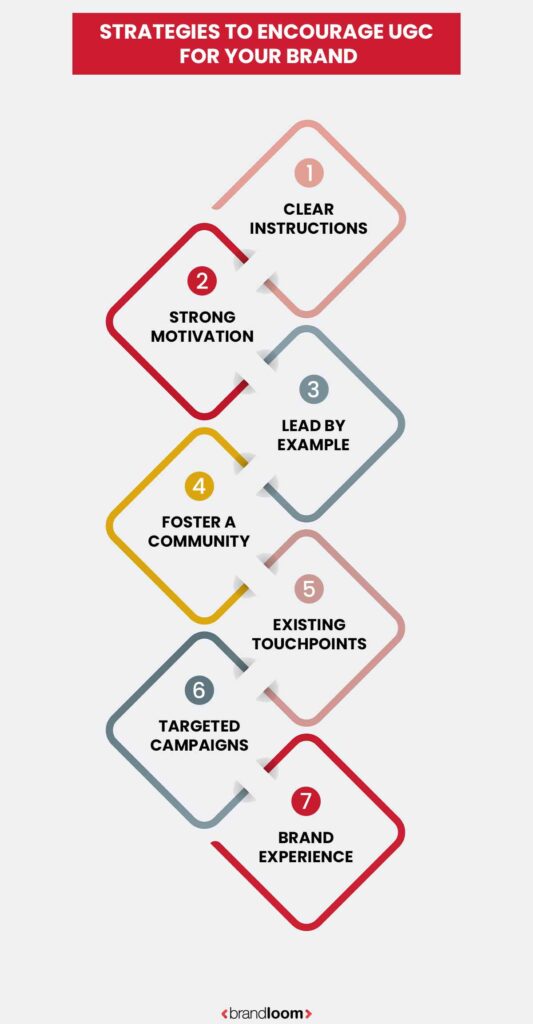
1. Clear Instructions
You can clearly ask your target audience about what to share and how to share. Clear instructions like – post a photo with your kids with the hashtag #MyKidsMyLife in it.
Creation and promotion of branded hashtags can lead to increased brand awareness. Easy tagging and submission methods can result in increased participation. UGC platforms like TINT can be considered.
2. Strong Motivation
From the feel-good factor to the tangible rewards, motivation works better than any other way to encourage the audience for UGC. Intrinsic motivation, such as fame, recognition, and self-expression, can help boost UGC.
A sense of belonging to a specific tribe or contributing towards a cause is also a key point to consider. As for the extrinsic motivation, contests or giveaways, discounts, brand features, etc., can work wonders.
3. Lead by Example
Nothing works better than letting the audience take a glimpse of what exactly you are looking for. Create a photo or video example and post it with a caption, asking the audience to follow this for their submissions.
Sending free samples to the loyal customers and asking them for detailed feedback is fair in every way. You can give them a specific question like “How did the XYZ product work for you?”.
4. Foster a Community
Brands that invest time in acknowledging and celebrating the UGC content creators witness a rise in the incoming user-generated content. As the individuals feel valued, they proactively become a part of the process.
For the others, they participate at some point in time to be a part of this community that celebrates and uplifts each other. Steps like “Fan of the week” can be the cherry on top.
5. Existing Touchpoints
A product with attractive packaging interests the buyer to make content out of it. The job becomes easier if there is a QR code given by the company on the packaging to lead the customers towards the path of UGC.
Emails asking for a picture and review of the product or encouraging them to check in are ideal. If you see a customer sharing a good rating, ask them for a review as well.
6. Targeted Campaigns
Focused campaigns can be helpful in collecting high-quality UGC. Campaigns that ask customers to share before and after pictures to showcase the effectiveness of their product, or ask for a 30-day experience after starting to use the product, generally receive content that aligns with the brand voice.
Also, seasonal campaigns or unboxing videos are great ways to connect with the audience, value them, and obtain quality content. BrandLoom, India’s one of the best social media marketing agencies, can curate focused campaigns for your brand.
7. Brand Experience
Social proof of your product’s effectiveness can help you attract more buyers. In this context, nothing works better than UGC. Ask for informed consent from the UGC content creators and post those everywhere.
From your social channels to your official website, featuring UGC can instantly level up your trust factor, influencing buying decisions and increasing conversions.
Key Differences Between UGC and Influencer Marketing
There are certain factors that distinguish influencer marketing from user generated content (UGC). Let us take a closer look.
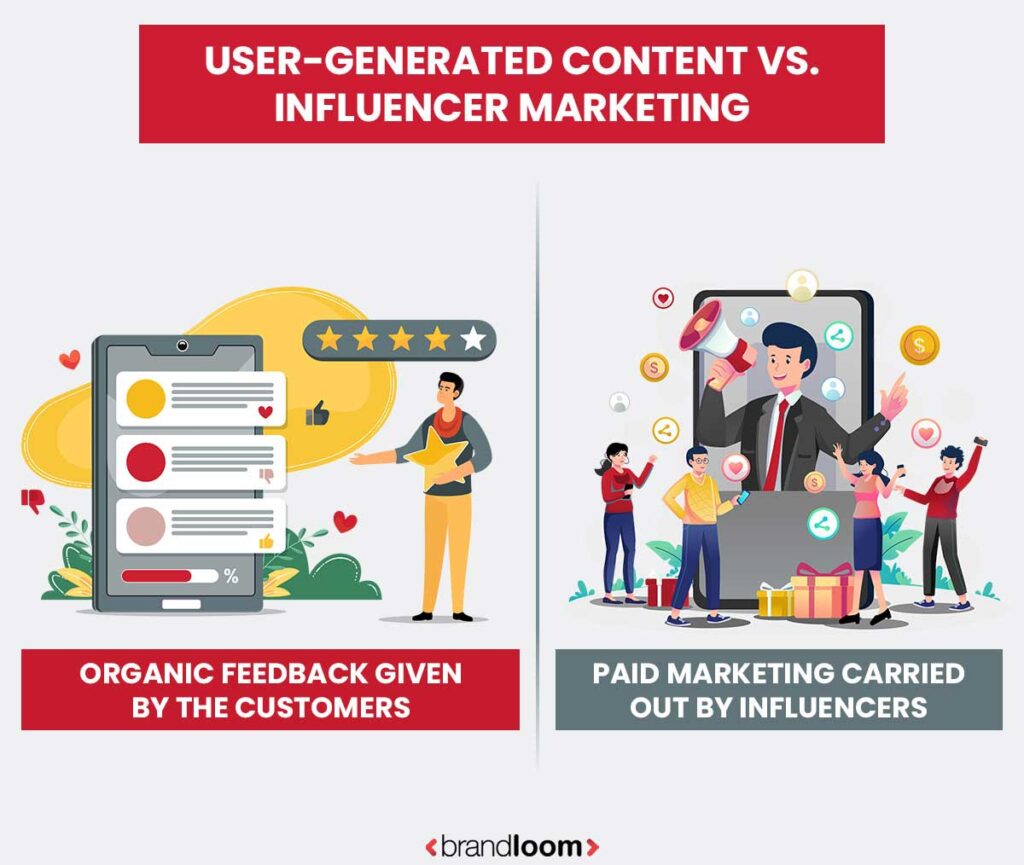
| Influencer Marketing | User-Generated Content |
| 1. Brand approaches social media users with high follower counts as their influencers. | 1. Any customer can provide user-generated content to brands. |
| 2. This is paid marketing where brands pay the influencers for their content. | 2. This does not involve money. UGC is shared as customer feedback on products. |
| 3. The brand has high control over the influencers with detailed briefs. | 3. There is zero to poor control of the brand over the UGC content creator, as the content is organic. |
| 4. Influencer marketing is expensive, as the cost increases from nano to micro influencers. | 4. This is a cost-effective method as there is no payment involved. However, the brands can recognise the posts through a simple acknowledgement, such as sharing. |
| 5. Polished content yet low credibility. | 5. Lack of perfection, yet highly credible content. |
| 6. Budget and the availability of the influencer can restrict the progress. | 6. Highly scalable as UGC is driven by community engagement. |
Challenges In User Generated Content (UGC) and How To Navigate Them
There are certain challenges linked to UGC that might hinder your brand’s growth. Let’s look at those along with some measures that can be taken to navigate them.

1. Relevance & Quality Inconsistency
- Challenge: Video reviews can be blurry or shot in poorly lit areas, resulting in quality issues. Also, the UGC may not align with the brand tone.
- Solution: Focused social campaigns with branded hashtags can direct these UGC content creators to the right path. With clear guidelines, their content will be more relevant to the user. Recognition or small rewards for on-point UGC can work wonders, too.
2. Negative Content
- Challenge: Negative reviews or offensive testimonials can harm the brand image. Spammy comments from the trolls count too.
- Solution: A combination of clear community guidelines, transparent response protocol, crisis management plan, and balanced replies can help to tackle the situation. Even if it seems inappropriate, negative feedback may help you find the operational gaps and improve your product further.
3. Legal Issues
- Challenge: While most customers will love the acknowledgment, some of them will not be as happy as the rest. Copyright infringement claims are inevitable if you are using a UGC without the explicit permission of the poster.
- Solution: Besides explicit consent from the user, clean terms and conditions for UGC submission will help you acquire specific rights to use. Also, crediting the creator by tagging them in the post can also help surpass legal complexities.
4. Discovering Quality UGC
- Challenge: Not all UGC is usable. It is very difficult to find high-quality content that aligns perfectly with your brand value and can drive lasting results.
- Solution: Actively look for the tags and mentions with branded hashtags, and sort the good quality ones. Specialized tools can also be used to locate superior quality user created content.
5. Avoiding Fake UGC
- Challenge: At times, businesses pay to get overly curated UGCs. These fake UGC are of no use to the brands.
- Solution: Prioritize general customer reviews over the ones received in exchange for money or free samples. Brands can be transparent by asking the individual to use a ‘paid marketing‘ badge.
6. ROI Measurement
- Challenge: The impact caused by user generated content UGC cannot always be measured properly. Hence, measuring ROI becomes difficult.
- Solution: Besides tracking dedicated campaigns, monitoring key metrics, A/B testing, and customer surveys help to measure ROI by connecting the dots. Apart from quantitative output, it is essential to assess the holistic value of the UGC as well.
KPIs To Measure User Generated Content (UGC) Strategy
While UGC focuses on boosting brand growth through authenticity and credibility, measuring the success rate is harder than you think. There are multiple KPIs you can follow to assess the overall outcome.
- Content is the foundation. Metrics like UGC submission rate, total collected UGC, unique contributors, and campaign-specific submissions help brands to track content volume.
- Brand awareness is the key goal. Reach and awareness metrics, such as share of voice, organic impressions, branded hashtag usage, and UGC amplification rate, can be considered in this context.
- UGC is aimed at boosting audience interaction. Metrics like UGC engagement rate, average engagement, number of comments and shares, and CTR (click-through rate) can be helpful.
- Conversions are the key action the audience is expected to take. UGC-associated conversion rate, total sales, average order value from referrals, lead generation, and content utilization rate can be monitored to track progress.
- Brand perception and trust metrics, such as customer trust score, brand sentiment shift, net promoter score (NPS), and review volume, help to track and add long-term value.
- Content moderation rate, content relevance score, and the emotional impact of UGC enable the brands to monitor the quality and relevance of the user created content.
Conclusion
User generated content campaigns can drive lasting impact on your revenue. As the brands opt for UGC marketing to improve business outcomes and build trust among the target market, it is essential to focus on the challenges as well.
Besides exploring the user-generated content benefits and showing how to create a user content marketing strategy, the challenges have been evaluated, too. Appropriate solutions have been suggested to close those gaps and ensure optimum business outcomes.
As more brands aim to increase trust with customer content, it is evident that UGC has become a popular marketing method in the present time.
If your brand is not following these strategies, you may not survive this highly competitive market. BrandLoom, India’s leading social media marketing company, can create campaigns that work for your brand’s growth.
Frequently Asked Questions
User generated content (UGC) refers to any unpaid content on a specific brand provided by the customers or the general public. Some of the examples are images, videos, testimonials, social media posts, blogs, etc.
Nowadays, customers prefer real content over fabricated content or brand endorsements. In such a scenario, user generated content (UGC) is like a breath of fresh air in the world of content marketing.
When it comes to trust and authenticity, UGC scores higher than endorsements. New-age customers prefer looking at real reviews rather than celebrities endorsing a product. As user generated content UGC is more genuine in nature, it is trusted by customers, enabling brands to make the most of it.
When a UGC is shared, it improves brand loyalty. The customers feel valued, increasing satisfaction levels. Unlike professional content, UGC is cost-effective and scalable. Brands can utilize it to drive sales.
User generated content (UGC) makes a significant impact on customers’ buying decisions. Unlike the polished endorsements by celebrities, this content is more genuine.
When the target customers come across such content, there is an instant buildup of trust. People feel more connected to such content as they get to see and hear from real individuals.
UGC is an organic way of attracting leads and influencing conversions. Such content covers underlying queries of the audience regarding the product.
This transparency lowers perceived risks. With diverse use cases, user generated content (UGC) allows the audience to imagine themselves as user.
Thus, it organically helps with their buying decisions. BrandLoom, India’s leading influencer marketing agency, can help to build trust among your target market and drive sales.
Leveraging UGC for brand trust is the best thing businesses can do. When a user posts something about a brand, be it positive or negative, it attracts the target audience.
This not only boosts brand awareness but also enables the users to understand the benefits of that product. Leveraging user generated content (UGC) helps to enhance brand loyalty as users who post this feel valued.
As the users come across real content by real people, they can connect better. It seems more organic. Unlike the polished content, UGC may have flaws, but that is what makes it more relatable to the target audience.
Also, these campaigns boost brand awareness by creating buzz about the product. BrandLoom, one of the top influencer marketing companies in India, can connect you with the right people to maximize reach.
Brands can come up with social media campaigns focused on a new product or any seasonal offer. They can ask the audience to post comments, photos, or videos using a specific hashtag.
This hashtag should be meaningful and catchy so that more people will be encouraged to post original content. This user generated content (UGC) will help to promote their new product or offers and maximize sales.
Giveaways and contests are key ways to encourage users to post original content on your product or service. The brand urges social media users to comment and share their posts to spread the word.
It helps with brand promotion and generates numerous UGC. Highlighting the customers with admirable UGC motivates others to share as well.
When it comes to branded content, they mostly lack originality. Most of that content seems fabricated and is too polished to attract the general public. In most cases, branded content means celebrity endorsements.
However, not every time can celebs connect with the common people. These contents seem too perfect and sometimes fail to tap into the audience’s pain points.
As for the user generated content (UGC), the audience comes across real people and original content. They can connect well as the content seems to be coming from an ordinary person, just like them.
Therefore, UGC can attract more leads and maximize revenue. BrandLoom, India’s one of the best social media marketing agencies, can solve the content puzzle for your business.
The user generated content (UGC) is a social proof that the customers like the products offered by your brand.
As these contents are shared by real customers, who state their real experience, the audience finds it authentic and trustworthy.
Therefore, UGC helps to connect people with brands through people and maximize sales.
Here, brands encourage customers to create UGC for two reasons.
Firstly, it helps with brand promotion and creates awareness.
Secondly, it forms a two-way communication where the brand knows that they are on the right path.
Also, user generated content (UGC) multiplies revenue through positive product reviews and testimonials.
User generated content (UGC) is the key to unlocking the true potential of your customer base in boosting your brand’s growth. Here, the brands rely on the customers to expand their customer base.
If a brand posts UGC from its site on a regular basis, it boosts SEO performance. These contents are fresh, so the search engines crawl your site more often, making an impact on its rankings.
The long-tail keywords are naturally encrypted in the UGC, making the content search-friendly. As the visitors tend to spend a longer time exploring such content, the search engine gets a signal that your content is of high value.
For instance, if you are looking at a blog with many comments, you tend to stay there for longer, reducing the bounce rate. BrandLoom, one of the top SEO service providers in India, can help you maximize your website traffic.
User-generated content benefits can go a long way. There are several effective paths through which brands can showcase UGC on their site.
– The brands can use customer-provided content (e.g., images and videos) to turn into shoppable galleries. For example, in the sites where customers can preview their look before making the purchase, the pictures can be stored on the same product page.
– Auto-generation of review-driven product badges helps to boost trust and drive conversions. For instance, products with maximum reviews stating a perfect fit should get a badge like “Top rated for fit” to increase sales.
– Q&A sections below the product page can help solve customer queries and also drive sales. Meanwhile, this content naturally has long-tail keywords, which boosts the reach of the web page as well.
Authentic brand storytelling with UGC can help businesses reach numerous potential customers. UGC meaning original content coming from ordinary people.
Therefore, the target audience can deeply connect with the content and find similarity with their situations. This makes them make a comment under a user generated content UGC or share it with their peers, thereby maximizing its reach.
As individuals tend to prefer UGC over traditional ads, it organically compels the audience to engage with the brand.
For example, when you are on a product page and there are many reviews with images or videos, you instantly feel that urge to make a purchase. This is how UGC helps brand growth through increased engagement.
Many businesses want to use UGC but wonder about how to collect user-generated content. There are plenty of ways through which brands can do that.
They can start a social media campaign with a catchy hashtag. When individuals come across branded hashtags with UGC content addressing a concern related to them, they often feel an urge to be a part of it.
For example, if there is a Mother’s Day campaign where the users are asked to post pictures with their mothers or kids, they instantly feel an urge to engage.
This leads to the generation of more UGC, thereby making the brand successful in mining user generated content. BrandLoom, India’s leading social media marketing company, can curate engaging campaigns for your brand.
UGC stands for user-generated content. Such content comes directly from the user and is not as polished as a traditional ad. The user generated content examples are customer reviews or testimonials in the form of text, visual, or audio-visuals.
These are focused on highlighting real-life solutions the products can bring, allowing the audience to connect with the brand in a deeper way.
The best examples of user-generated content can be a real user explaining how the product has benefited them, and the pros and cons of it. This can be in the form of a social post or video content.
UGC aims to build trust so that customers can make purchases knowing that it has benefited real people, too. User created content may be flawed, but the authenticity it carries can overshadow everything else.

